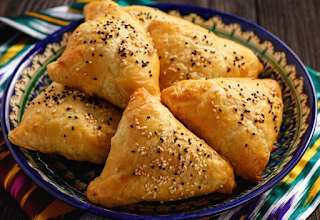The most popular street snack of Southeast Asia without a doubt is Samosa. It could be found prepared and sold in almost every street of India. The best part is, there is no specific time to eat or serve samosas, they are considered the first choice with the evening tea and they are the must have snacks for every Indian party. These mouth watering, triangled shaped, deep-fried, and full of taste mostly consist of potatoes, lentils, peas, and spices as filling are served with khhatti and meethi chutney to enhance the taste.
Brief History:

When Britishers arrived in India, they also got mesmerized by its taste. The impact was so strong that till date it has a strong presence as one of the most popular snacks with evening tea in the UK.
Filling
Till 13th century meat, onion and dry fruits were used as filling in samosas, but with the passage of time it kept on changing from region to region. When samosa reached India, experiments with its filling started and to make it cost effective or to prepare it as per the local taste buds many experiments were done and finally boiled potatoes, lentils, and peas with local spices made the perfect blend as a filling for this popular snack.
In historical context, it has been mentioned by the names as 'Sanbusak', 'Sanbusag', and 'Sanbusaj' eaten by the traveling merchants as snacks next to the campfire before the main course. The mention of samosas could be found in Arabic recipes books of the 13th century under the same names as 'Sanbusak', 'Sanbusag', and 'Sanbusaj'. 'Samsa', 'Sambusa' and 'Sambura' are the names still used in some central Asian countries. For example, 'Sambura Baraki' in Tajikistan are triangle shaped meat filled pastries flavored with local spices, onion, and cumin seeds which are baked not deep fried like in India.
Samosa today is served in many ways, most people prefer when served hot with sweat and spicy chutney, and green chutney prepared from mint, chilies, and coriander. In some parts, people prefer it served with chickpeas prepared with thick and spicy gravy.
In Odisha, Bihar, and Jharkhand it is known as shingaras and served hot with evening tea. In south India, its shape is little different, it mostly looks like goan chamucas. A mixture of potatoes, cabbage, and fried onions thoroughly mixed with curry leaves and chilies are generally used as filling.
It doesn’t matter samosa is Indian or not, but there is no doubt that it has been the most popular snack of India and can be tasted at any time of the day. It is so strongly connected to Indians that wherever they have gone in the world they have introduced samosas to the locals. It is the only snack which could be found everywhere from a local bus stand to the international airport and from the school canteen to the corporate office.




Comments
Post a Comment